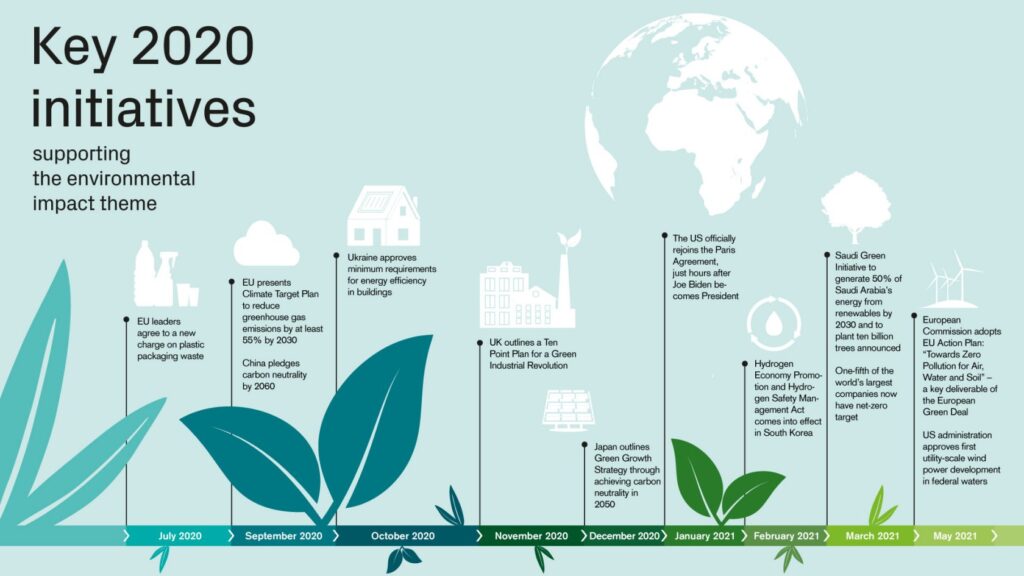We are witnessing a rapid shift in values toward sustainability on a global basis; investors, consumers, companies and regulators are all starting to consider new ways of doing things and starting to adapt their lifestyles and business practices to be more considerate of environmental issues. While this reorientation of society still has a long way to go, it is making the idea of “sustainable investing” a significant theme in the investment industry.

Sparked perhaps by Greta Thunberg and other well-known public figures, we see the Millennial generation and Gen Z as driving forces behind this shift, and they are spurring others into action. These two generational cohorts, which claim more vegetarians and vegans than any other in the modern age, are vocally committed to environmental and social issues, and their voice is empowered by the mobile phone and the broad global reach of the social media channels.
Businesses, investors, governments and regulators are all playing catch-up in this changing landscape. Investors are learning fast to appreciate the importance of sustainability in society and the business world, and therefore the need to adopt an ESG (environmental, social and governance) framework in their investment decisions.
From avoiding losses to solving problems
There are a number of different approaches to integrate ESG and sustainability into an investment decision process. The aim of ESG integration, the most important and commonly used ESG approach, is to integrate material ESG factors across the investment process – from research and security valuation through to portfolio construction and monitoring – in order to make better-informed investment decisions. Best-in-class strategies typically limit the investable universe of companies to those with above-average ESG ratings in their industry. Other strategies simply avoid potentially problematic areas such as sectors with extremely high energy intensity, or which use rare earth metals or other limited natural resources. Other strategies emphasize their active engagement with company managements to encourage better business practices to improve ESG issues.
Clients who would like their investments to have exposure to firms that offer solutions in the environmental or social area can choose strategies that focus on investment themes aligned with the UN Sustainable Development Goals (SDG). Investing, for example, in companies that develop clean energy technologies or recycling or climate change mitigation solutions. The purity of a fund’s exposure to its theme is clearly a critical issue, which clients need to monitor closely. Some funds that claim to offer a theme focused on environmental solutions may in fact have very little direct exposure to the advertised climate change solutions. Caveat emptor. The greater the purity to the theme, the greater the exposure to firms with a positive contribution to the SDG.
ESG integration in China
Some more tactical ESG strategies focus on evaluating a company’s ability to raise their game and improve their ESG credentials from a low starting point. This is particularly pertinent in emerging markets, and in the case of China, where ESG considerations are still generally lower down the list of management priorities. However, this is rapidly changing. According to a study by the United Nations (UNEP FI/PRI)1, in 2009 only 43% of the largest 300 companies on the Shanghai stock exchange (the CSI 300 Index) voluntarily disclosed ESG data. By 2018 this proportion had risen to 82%. In addition to reporting more ESG statistics, the country is also moving with the times, and adopting more sustainable energy solutions. China’s solar energy installation footprint is slated to rise by 50% before the end of 2025 – an incredible achievement with a meaningful impact on rolling back the effects of climate change.
Sustainable investing not only helps the environment and society but is also starting to prove to be a positive factor in investment performance. Perhaps this is a self-realizing “virtuous circle.” As the popular momentum behind sustainability increases and more investors adopt ESG integration processes, companies that score well on this front are likely to perform better than those that score poorly. This surely is free market capitalism at its best: allocating capital responsibly, to improve sustainability and deliver investment performance, and by the same token punishing companies that show little regard for raising their ESG ratings, or to the economic externalities they create.
Tipping point
Product specialist Equity
Our planet is at a tipping point. It’s more important today than ever before to take action. With some of the world’s largest countries and conglomerates stepping up to the plate, what can investors do to effect positive change, particularly in the public equities space?
Carly Brewster: Public equity markets are excellent platforms for channeling large capital flows into sustainable initiatives. By allocating funds to companies developing and producing the technologies to help solve environmental challenges like climate change, investors can make a real difference. They provide companies with the capital required to develop these solutions, and they give a clear signal to the market that these technologies are becoming more and more relevant.
What kind of companies are these? What kind of technologies are they delivering and how exactly do they create impact?
The Environmental Impact Strategy invests in companies that deliver environmental innovations enabling others to reduce their ecological footprint. These include companies developing solutions for energy-efficient buildings and transportation, technologies that enable heavy industry to use less material and produce less waste, smart recycling solutions for industry, and clean energy production. What’s more, engaged investors can play an active role via proxy voting and by entering into direct dialogue with the companies they invest in.
Is there a yardstick for assessing impact? What do investors usually look for in these companies when thinking about making a difference?
They select companies offering products and services that ultimately help others to pursue sustainability goals. This generally has the greatest impact by helping corporations and communities reduce their carbon emissions, use less energy, materials and natural resources, dispose of waste more responsibly and increase the amount they recycle. In addition to looking for companies that make a significant impact through the technologies and services they provide to the market, investors should also consider how these companies contribute to the Sustainable Development Goals.
Is this impact significant? Are you able to measure the level of impact your portfolio companies are having?
Experienced investors can measure the impact that companies make, but it requires a thorough analysis. Deep-diving into companies’ annual reports and sustainability publications is just as important as direct engagement with the companies’ senior management. These activities enable investors to determine the degree of impact and report on measures such as megawatt-hours of electricity saved, CO2 emissions avoided, cubic meters of wastewater treated, and tons of recycled plastic kept out of our waterways.


